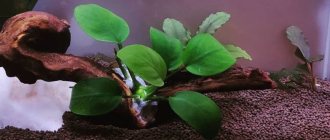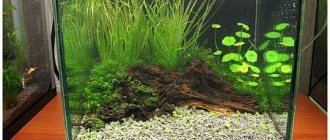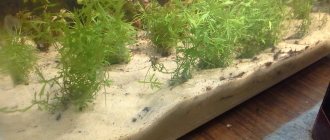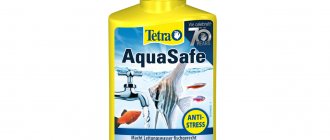In order for an aquarium to be a truly cozy and comfortable home for fish, there must be soil at the bottom. It not only decorates the biotope and gives it individuality, but also has practical benefits: it collects fish waste, beneficial bacteria live in it, and it creates biological balance. Aquarists face several questions. What soil to choose for an aquarium? River sand or sea pebbles? If the pebbles are large or small? Should I choose black soil or white quartz sand? Or maybe add some garden soil? The second question is calculating the amount of soil: what thickness of layer would be ideal, and how much to buy in kilograms? The answers depend on many factors.
Aquarium soil: where to get it
It seems that there is nothing easier than running to a neighboring river or lake and picking up as much sand or stones as you want. However, such a substrate will create many problems:
- It can introduce infections from natural bodies of water into the aquarium, even if prevention is carried out before placing it in the aquarium;
- It may turn out that the soil is not suitable for aquarium fish in size or shape: too small, large, sharp;
- Finally, stones that looked romantic in the lake can ruin the entire impression of the aquarium: they turn out to be simply ugly.
On the shelves of pet stores you can find different types of soil: natural, colored in variegated colors, large and small, eco soil. Companies that produce products for aquariums offer not only equipment, but also decorative details: soil, decorations, large stones, shells, etc. Branded is always safer and more reliable.
Advantages
White aquarium soil is very popular. It has many advantages, thanks to which aquarists use it in their artificial reservoirs.
- Decorativeness . An aquarium with clear water and a snow-white bottom looks very decorative. Herbalists are especially beautiful. Here, plants on a white background look much brighter than when using substrates of other colors. Such a reservoir is not just a container in which fish and aquatic plants live. It becomes the main decorative element in the design of the room.
- New design solutions . Creators of aquarium landscapes appreciate white substrate. They often use this color for complex aquarium compositions. There are many options for using light-colored substrates in combination with primers of other shades. With its help, you can easily create a landscape with a bright clearing in the foreground or a light path among the stones.
- Possibility of changing the composition of water . To keep some types of fish, alkaline water is required. Many cichlids need this. Coral chips or marble are used as bottom material in cichlid fish. This material for arranging the bottom maintains water hardness at the required level. Also, large cichlids and decorations look beautiful against its background.
- Porosity and its advantages . The porosity of the bottom material is directly related to maintaining biological balance in the aquarium. This is very important for the functioning of any indoor reservoir, both sea and freshwater. The most porous material is coral chips. It is indispensable for marine aquariums, where ensuring biobalance is of particular importance. This natural substrate can also be used for freshwater reservoirs.
- Environmental friendliness . None of the white aquarium soils discussed here release substances harmful to aquarium inhabitants into the water. Even an artificially colored substrate can be called environmentally friendly. The dye does not contain toxic or harmful substances.
Which soil should I choose?
Several factors influence the choice of substrate:
- The desire of the aquarist himself. He decides which one is more suitable for the design of the biotope: white, black, colored, natural soil.
- Aquarium population: some fish need fine quartz sand, while others need smooth rocks on the bottom. A huge number of fish are not at all interested in what is below, and this is convenient.
- Required water parameters. For example, coral chips can change hardness because they contain a lot of calcium. For some fish (especially cichlids), hard water is essential. For others, on the contrary, it is contraindicated. It is better to find out about the properties of the selected soil in advance.
- Tank size. A small “jar” will accommodate soil up to a maximum of 4 mm. Large pebbles up to 7 mm are good for large volumes.
- Availability of plants. This is a special topic. Living plants in an aquarium dictate their own rules: create growth conditions and correctly lay the substrate.
How to choose sand for an aquarium
Having decided on the type of soil, you should pay attention to the quality of the sand. The parameters of the sand substrate should be as follows:
- The grains of sand are chosen to be the same size – no more than 1.5 mm. A smaller fraction will impede the circulation of oxygen, and sand grains of different sizes will contribute to the formation of ammonia and hydrogen sulfide.
- Regardless of the variety, the sand substrate should not affect the quality and color of the water. For example, you cannot use the limestone type when keeping fish that prefer soft water.
- If soil from a natural reservoir was chosen as a filler, then the sand should be washed and calcined in the oven to get rid of debris and destroy harmful bacteria.
- When deciding to use a colored variety, you need to make sure the sandy soil is safe. Experts do not recommend using red or yellow substrates, as they contain large amounts of iron oxide, which is harmful to pets.
- When choosing a substrate of white tones, it should be taken into account that light sand dulls the brightness of the color of the fish.
Ground color
Since the substrate will be the basis of the design, aquarists look first and foremost at its color.
- Natural - this kind of soil covers the bottom of familiar reservoirs, rivers and lakes in abundance. Gravel, small river pebbles, and granite have natural shades. The soils have a calm natural shade; they contain light and dark stones, which, when mixed, create the impression of a cozy and warm bottom. Natural soil goes well with any color of the back wall: black, blue, illustrated.
- Black soil for an aquarium – basalt, black quartz (including sand fraction). With the right lighting and decoration it looks especially impressive. It is used infrequently, so it seems unusual and attracts attention. Convenient for observing fish and shrimp.
- White soil is mainly snow-white quartz or white pebbles. It looks luxurious when decorating the back wall of the aquarium with blue film. This is how designs called “pseudo-sea” are created.
- Colored primer - can be either monochromatic or mixed. Artificially colored crushed stone, glass, and different types of stones are used. This filler is not recommended for use at home: it is impossible to predict how it will affect the water and whether it will be able to adequately perform its functions.
Color and size of quartz sand
This sand comes in several sizes - dusty - 0.1 mm , fine-grained - 0.25 mm , medium-grained - up to 0.5 mm , and coarse-grained - 3 mm .
The color ranges from pure white to black, which is considered rare and therefore the most expensive type of quartz sand. Its other name is morion . It contains aluminum impurities and looks very impressive in an aquarium.
When choosing the color of quartz, it is necessary to take into account the color of the fish - the lighter and more transparent they are, the darker the soil should be. You can also use painted sand, but you should make sure that the painting is done with high quality and will not harm underwater inhabitants and plants.
Types of soil according to different criteria
By origin:
- Natural (aquarium sand, lava, tuff, quartz soil, sea and river pebbles);
- Processed (vermiculite, baked clay);
- Artificial (glass soil, plastic balls).
Based on their effect on water, soils are divided into:
- Neutral, which do not affect water and do not help plants;
- Carbonate, with a high calcium content (shell rock, coral chips);
- With impurities that may be harmful to fish (for example, colored substrate, garden soil, stones with weak radioactivity).
The size of the soil is:
- Dust-like - fraction up to 1 mm, unsuitable for most aquariums, as it is difficult to clean;
- Fine-grained - fraction 1-3 mm, chosen when it is planned to grow plants with a weak root system in the tank;
- Medium grain – 4-6 mm, suitable for flora with a good root system;
- Coarse-grained - more than 7 mm, rarely used, as it does not create a sufficient “biological cushion” and is not suitable for the nitrogen cycle.
The nitrogen cycle is a chain of chemical reactions in which ammonia from fish waste passes through nitrite ions into nitrates. Proper nitrification is extremely important for any aquarium fish.
Commercial mixtures are specialized. For example, denerle is a soil that is excellent for plants. Neutral safe soil Tetra is designed for comfortable keeping of fish.
What is quartz sand
Quartz is a fairly common natural white mineral mined from the earth's crust. After the procedure of extraction from the ground and washing, it is broken down into fractions of various sizes - from small 0.1 mm to large ones - over 5 mm .
Quartz sand differs from ordinary sand in its homogeneity of composition, better susceptibility to dirt, more pleasant appearance and other positive characteristics, which will be described below.
Is it true that sand is an ideal soil?
Quartz sand is used very often for aquariums. The benefits of white sand are obvious: it is beautiful, aesthetically pleasing, neutral to water, and looks rich. Sand is very good for growing plants. In addition, sand removes manganese and iron from the water (giving these minerals to plants). Harm - quartz sand clouds the water, this is especially noticeable after starting the aquarium and after each cleaning. The finer the substrate, the longer the suspension remains in the water after maintenance. Sand is not suitable for fish that live in the soil or directly on it: macrognathus, acanthophthalmus, stingrays.
Soil with a fraction of 3-5 mm, with a smooth surface (river pebbles), is considered ideal. It provides biological balance, water circulation, is easy to clean and has sufficient porosity.
Classification of substrates
Aquarium sand as a substrate has many advantages. But to take full advantage of them, you need to familiarize yourself with its characteristics. The main types of sand are:
- River. It has been used in aquariums for a long time. It is considered perhaps the most optimal option. You can buy it in a specialized store or assemble it yourself. In the latter case, you will have to use two sieves. They will be needed to filter out large particles and debris.
- Quartz. It can be obtained by crushing white quartz. Such a substrate has many advantages, in particular, resistance to external influences. This is a neutral material that does not make the water harder and neutralizes harmful components that form in the aquarium. These include manganese and iron oxide
Quartz sand can be obtained by grinding white quartz - White aragonite. Formed from fragments of coral and shellfish. It is important to understand that white sand for an aquarium makes the water harder, so it should not be used for fish living in bodies of soft water.
- Black. Includes particles of magnetite and hematite. It is the result of washing out light rocks. This soil does not change the hardness of the water, which is its advantage.
A special category is sea sand. It is also called “alive”. It is mined in the coastal zone, in close proximity to the coral reef.
Sea sand received its own name due to the special method of its extraction. It is immediately packaged without drying it first. Due to this, the microflora is completely preserved in it. This soil is best suited for an aquarium with marine inhabitants.
Sea sand is perfect for an aquarium with sea fish
What soil is not suitable?
How to choose soil so as not to harm the fish? You should definitely avoid the following types of bedding:
- Garden soil is not good enough to create the right biological conditions, in addition, it contains a huge amount of chemical elements that are not suitable for water;
- Glass soil - fish waste products do not go through the nitrogen cycle, but simply settle on it in the same way as on the walls of an aquarium. It brings no benefit, but can cause harm;
- Expanded clay and clay are not suitable for most aquariums, as they are highly porous, accumulate harmful substances inside, and do not allow proper cleaning of the bottom.
Aquarium soil care
The soil must be looked after, otherwise a large amount of harmful products will accumulate in it, which gradually begin to poison the inhabitants of the aquarium. The cleaning process is quite labor-intensive. The soil is stirred up with a stick and the water with the rising suspension is sucked off with a specially prepared hose. This work must be done very carefully so that the roots of the plants remain intact and the fish are not harmed.
It will not be possible to clean all the soil and there is nothing wrong with that; on the contrary, the remains of organic matter are necessary to maintain plant life. They work like fertilizers. There are no ideally clean aquariums; nothing lives in them. Cleaning is done once every two months.
The question of which soil is best to choose for an aquarium is quite difficult and here it is necessary to consult with more experienced colleagues in the hobby. It never hurts.
Did the article help you?
Andrey
Ask questions
Ask questions and write answers in the comments
How to calculate the amount of soil
On average, the soil layer should be 6-7 cm. A layer of less than 5 cm does not cope with the tasks: both decorative and life support issues for fish.
How do you know how much soil you need?
- Buy packs of several kilograms and fill the aquarium until the layer is sufficient.
- Calculate the amount of soil using the formula: Substrate mass (kg) = Layer height in cm * aquarium width * aquarium length * 1.5/1000 . Calculation of soil for an aquarium of non-standard shape is carried out approximately based on its volume.
After calculating the soil, it is better to prepare a little more substrate to make sure there is enough. Don’t get carried away; a bottom layer that is too thick will not decorate the tank and will make it difficult to care for.
How to prepare the soil
Any purchased soil requires preparation. Even if it is a proprietary mixture, it should at least be rinsed under running water. The exception is laterite - it contains iron, which is useful for plants, which will simply be washed away under running water, and the soil will lose its properties.
For washing, it is convenient to use a colander or a bucket with a hole in the bottom. Preparing the soil helps rid the substrate of dust that appeared during packaging and transportation.
If the filler is of questionable origin or even brought from natural sources, it should be boiled for several hours. Such disinfection is often enough to kill dangerous bacteria.
It is strictly not recommended to use cleaning powders, soap, or chlorine: it is impossible to rinse the soil completely, and chemicals that get into the aquarium water will upset the acid-base balance.
Application
This soil is used as aquarium filler. Before use, you must first rinse the pebbles with warm running water to remove clay and sand particles, stirring gently.
Advice! It is not recommended to use disinfectants; they can be poorly washed off or absorbed and enter the aquarium, poisoning the water.
Then, for better disinfection, you can boil it for 1-2 hours in an aluminum container, then cool it in the same water and spread it out in a thin layer to dry, or bake it in the oven, without making the temperature too high (otherwise some stones may crack and uneven edges will damage the fish).
What to do if the pebbles hiss?
Sometimes, when testing with vinegar, such a filler may hiss . This means that it makes the water harder and alkalizes it. You can soften the water by boiling it, passing it through an osmotic purification system or buying bottled water, then there will be less hissing, but it cannot be completely removed, since this filler in any case makes the water harder.
Important! It is better for a novice aquarist not to use sizzling soil.
Adding ennobling chemicals will not help either. This is not so scary, there are fish that tolerate hard and alkalized water well, but for plants, hard water is not a very good option, the optimal pH is 6-7.
The pebble bottom is cleaned in the same way as other types of fillers using a siphon.
How to properly lay soil in an aquarium
There are two installation methods:
- Pour soil into an empty aquarium and then fill it with water.
- Fill the tank with water about a third, then add the substrate there.
Both methods are equivalent and require especially careful handling: careless sharp movements can damage the walls and bottom of the aquarium.
After placing the filler, it is leveled, the tank is filled with water and decorative elements are installed on the bottom. Immediately turn on the filter. After 2-3 days it needs to be washed.
Properties
Here are some of the properties of this natural filler:
- Resistance to damage Due to the presence of a certain proportion of quartzite in the composition of the pebbles, it becomes resistant to various damages, and therefore can retain its presentation for quite a long time.
- Water resistance Low hygroscopicity is another useful property of pebbles. Due to its structure, it almost does not deteriorate in water, as a result of which the aquarium retains its beauty for a long time.
- Decorative properties These pebbles consist of many individual fragments of different colors, with its help you can create a motley and multi-colored bottom of the aquarium, which will delight the eye for a long time.
How long does soil last?
On average, the lifespan of one portion of filler is 5 years. Even with constant regular cleaning, the soil becomes unusable: it silts up, becomes covered with algae, and loses its properties. In addition, choosing a new soil means changing the design and appearance of the aquarium.
You shouldn't do this too often. Replacing the filler is a restart of the aquarium. It is better to transplant the fish into a quarantine aquarium for several days. Why this is done: so that the fish do not swallow a small stone suspension, which one way or another will still remain in the soil and end up in the water.
It takes at least 10-14 days for biological balance to be established. If you make mistakes during the process of changing the soil, a biological explosion may occur: the water in the general aquarium suddenly becomes cloudy due to the abundance of bacteria that multiply at lightning speed. In this case, everything has to start again. Therefore, it is better to find out in advance in detail what kind of soil is needed, what is the best substrate to use for the selected fish and plants.
Cleaning Tips
Even with the perfect water filters, you still have to clean your aquarium from time to time. Some fish owners claim that this is quite a difficult matter. For this purpose, you need to purchase a siphon. It works on the principle of a vacuum cleaner - it pulls out water along with dirt without affecting the grains of sand.
To prevent the water purification system from drawing sand into the aquarium, you need to install a siphon
To work with a siphon, you need a bucket into which the liquid is drained. When the volume of the aquarium exceeds 100 liters, it is better to stock up on a long hose and run it directly into the bathroom. This will make working with him much more comfortable. Algorithm of actions:
- To treat sandy soil with a siphon, pre-settled water is prepared.
- Next, connect the cylinder of the device to the substrate. On some models you can find a bulb that provides traction.
- Then they walk along the bottom of the aquarium with caution and make sure that too much water does not go away. You need to take so much liquid that you have to change no more than 25% of its volume.
- As soon as the cleaning cycle is completed, add a new portion of water to the aquarium. You should not carry out the procedure near the roots of plants. The fact is that assorted garbage is nutritious food for them. In addition, a siphon can easily damage the roots.
In this video you will learn how to properly clean quartz sand in an aquarium:
Beginners may think that cleaning the substrate every week is good, but if the aquarium has just been purchased, you should hold off on this. There is no need to leave fish inside while cleaning the aquarium; moreover, some miniature fish may get inside the device.
When purchasing a siphon, you need to look at the dimensions of the hose. The larger it is, the faster water will be absorbed. For small aquariums, devices with high suction capacity will be superfluous. Before it has time to clean itself, all the water will end up in the bucket. If the water pressure is excessive, you can adjust it yourself by lightly pressing it. It is enough to treat the sand with a siphon once every 2-4 weeks. This period depends on how many fish are in the aquarium. The substrate will have to be completely changed once every 3 years.
How to properly care for the soil
The properties of the filler are lost if proper care is not carried out. Keeping and caring for aquarium fish includes weekly water changes and regular cleaning of the soil with a siphon. The siphon removes large dirt, waste and food residues, but does not disturb the biological balance. You need to clean the soil carefully, without actively stirring it, but simply pulling out excess dirt from the soil.
Pros and cons of such soil
The question of choosing a soil often worries novice aquarists who are setting up their first artificial pond at home. In order not to engage in “redesign” later with all the ensuing consequences, it is necessary to evaluate all the pros and cons of a sand bottom.
pros
- Naturalness - an aquarium of any size will look like a natural pond;
- Algae take root and feel better;
- Sand is preferable for some species of fish, which use it for spawning, burrow into it, eat particles, which helps improve digestion;
- It is easier to care for a sandy bottom - a siphon is suitable, which can be used to treat the surface like a vacuum cleaner;
- Some types of sand add hardness to the water, which is useful, for example, for cichlids.
Minuses
- Long, several steps, initial preparation of sand for the aquarium;
- The aquarium will have to be cleaned more often, since this substrate quickly becomes dirty with waste from the inhabitants;
- Pure sand contains a small amount of nutrients, so plants will have to be fertilized;
- Some varieties may add additional chemical elements to the aquatic environment, which is not always beneficial.











